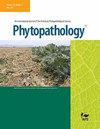New Approaches to Plant Pathogen Detection and Disease Diagnosis.
IF 2.6
2区 农林科学
Q2 PLANT SCIENCES
引用次数: 0
Abstract
Detecting plant pathogens and diagnosing diseases are critical components of successful pest management. These key areas have undergone significant advancements driven by breakthroughs in molecular biology and remote sensing technologies within the realm of precision agriculture. Notably, nucleic acid amplification techniques, with recent emphasis on sequencing procedures, particularly next-generation sequencing, have enabled improved DNA or RNA amplification detection protocols that now enable previously unthinkable strategies aimed at dissecting plant microbiota, including the disease-causing components. Simultaneously, the domain of remote sensing has seen the emergence of cutting-edge imaging sensor technologies and the integration of powerful computational tools, such as machine learning. These innovations enable spectral analysis of foliar symptoms and specific pathogen-induced alterations, making imaging spectroscopy and thermal imaging fundamental tools for large-scale disease surveillance and monitoring. These technologies contribute significantly to understanding the temporal and spatial dynamics of plant diseases.植物病原体检测和病害诊断的新方法。
检测植物病原体和诊断病害是成功病虫害管理的关键组成部分。在精准农业领域,分子生物学和遥感技术的突破推动了这些关键领域的重大进展。值得注意的是,核酸扩增技术以及最近强调的测序程序,特别是下一代测序,改进了 DNA 或 RNA 扩增检测规程,现在可以采用以前无法想象的策略来剖析植物微生物群,包括致病成分。与此同时,遥感领域也出现了尖端的成像传感器技术,并集成了强大的计算工具,如机器学习。这些创新技术能够对叶面症状和特定病原体引起的变化进行光谱分析,使成像光谱学和热成像成为大规模病害监测和监控的基本工具。这些技术大大有助于了解植物病害的时空动态。
本文章由计算机程序翻译,如有差异,请以英文原文为准。
求助全文
约1分钟内获得全文
求助全文
来源期刊

Phytopathology
生物-植物科学
CiteScore
5.90
自引率
9.40%
发文量
505
审稿时长
4-8 weeks
期刊介绍:
Phytopathology publishes articles on fundamental research that advances understanding of the nature of plant diseases, the agents that cause them, their spread, the losses they cause, and measures that can be used to control them. Phytopathology considers manuscripts covering all aspects of plant diseases including bacteriology, host-parasite biochemistry and cell biology, biological control, disease control and pest management, description of new pathogen species description of new pathogen species, ecology and population biology, epidemiology, disease etiology, host genetics and resistance, mycology, nematology, plant stress and abiotic disorders, postharvest pathology and mycotoxins, and virology. Papers dealing mainly with taxonomy, such as descriptions of new plant pathogen taxa are acceptable if they include plant disease research results such as pathogenicity, host range, etc. Taxonomic papers that focus on classification, identification, and nomenclature below the subspecies level may also be submitted to Phytopathology.
 求助内容:
求助内容: 应助结果提醒方式:
应助结果提醒方式:


